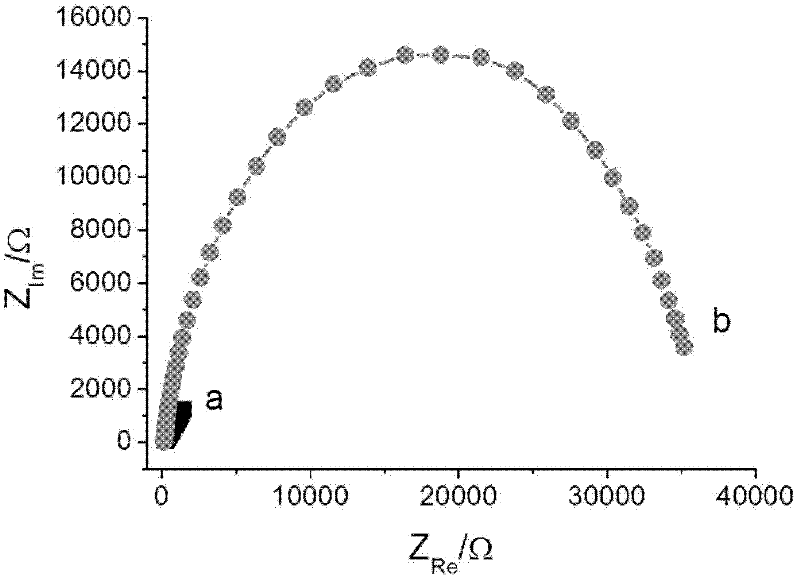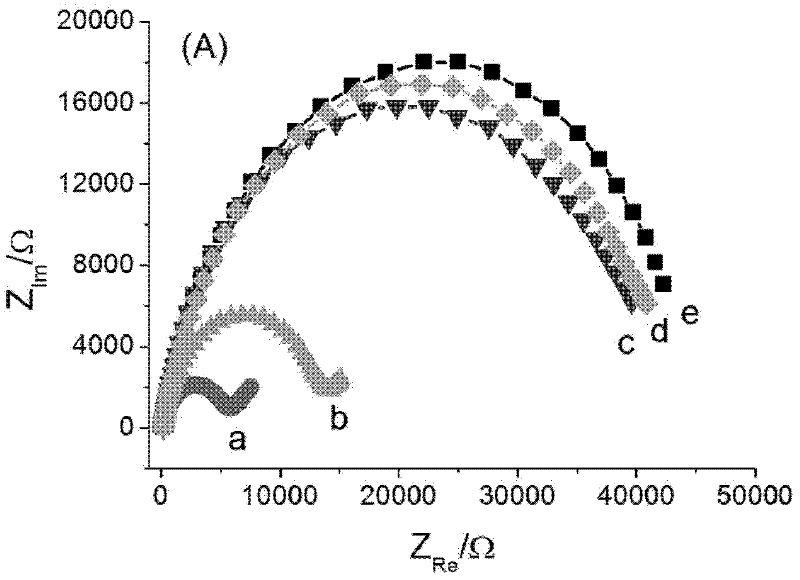AC Impedance-Type DNA Electrochemical Sensor Based on Probe DNA Controlled Assembly Interface
A technology of AC impedance and controlled assembly, applied in the field of biosensing, can solve the problems of high density of DNA probes, limited steric hindrance and charge, and insignificant changes in the AC impedance value of hybridization reactions, etc.
- Summary
- Abstract
- Description
- Claims
- Application Information
AI Technical Summary
Problems solved by technology
Method used
Image
Examples
Embodiment 1
[0031] The preparation steps of the AC impedance type DNA electrochemical sensor based on the probe DNA controlled assembly interface are as follows:
[0032] (1) Piranha solution (30% H 2 o 2 Concentrated H with a concentration of 98% 2 SO 4 , mixed at a volume ratio of 1:3) ultrasonicated for 5 min, ultrasonically cleaned with deionized water twice, each time for 5 min, and then washed with 0.3 μm and 0.05 μm Al 2 o 3 The mixture of water and water is polished to a mirror surface, followed by ultrasonic cleaning with ethanol and distilled water. Place the sonicated electrode at 0.5 M H 2 SO 4 The cyclic voltammetry scans to stability, washes with double distilled water, N 2 Blow dry for later use;
[0033] (2) Take 4 μl of probe DNA (oligonucleotides synthesized by Baosheng Bioengineering Co., Ltd.) solution, drop-coat it on the surface of the pretreated bare gold electrode, leave it at room temperature for 2 h, wash with PBS washing solution, double distilled water ...
Embodiment 2
[0035] The detection steps of the target DNA by the AC impedance type DNA electrochemical sensor based on the probe DNA controlled assembly interface are as follows:
[0036] (1) The capture probe immobilized on the surface of the electrode obtained in Example 1 and the target DNA (oligonucleotides synthesized by Baosheng Bioengineering Co., Ltd.) were hybridized in a hybridization buffer solution at 37 °C for 40 min in a water bath to form double-stranded DNA. Rinse the surface of the electrode with 10 mM PBS washing solution (pH 7.4) to remove unhybridized DNA strands, and then rinse with double distilled water before testing;
[0037] (2) Immerse the electrode prepared in step (1) in 4 mM K containing 0.1 M KCl 3 [Fe(CN) 6 ] / K 4 [Fe(CN) 6 ] (1:1) solution, the open circuit potential is the initial potential, and the frequency range is 10 5 Hz~1.0Hz, record the AC impedance curve. AC impedance diagram see Figure 3A The curve a.
Embodiment 3
[0039] The preparation of AC impedance type DNA electrochemical sensor and the detection steps of PML / RARα fusion gene are as follows:
[0040] (1) Piranha solution (30% H 2 o 2 Concentrated H with a concentration of 98% 2 SO 4 , mixed at a volume ratio of 1:3) ultrasonicated for 5 min, ultrasonically cleaned with deionized water twice, each time for 5 min, and then washed with 0.3 μm and 0.05 μm Al 2 o 3 The mixture of water and water is polished to a mirror surface, followed by ultrasonic cleaning with ethanol and distilled water. Place the sonicated electrode at 0.5 M H 2 SO 4 The cyclic voltammetry scans to stability, washes with double distilled water, N 2 Blow dry for later use;
[0041] (2) The sequence of the DNA capture probe labeled with thiol at the 5' end is: 5'-SH-(CH 2 ) 6 -T 10 CTTCA GAACT GCTGC TCTGG GTCTC AATGG-3', prepared as a 1 μM solution;
[0042] (3) Take 4 μl of the capture probe DNA solution in step (2), drop-coat it onto the surface of th...
PUM
 Login to View More
Login to View More Abstract
Description
Claims
Application Information
 Login to View More
Login to View More - R&D Engineer
- R&D Manager
- IP Professional
- Industry Leading Data Capabilities
- Powerful AI technology
- Patent DNA Extraction
Browse by: Latest US Patents, China's latest patents, Technical Efficacy Thesaurus, Application Domain, Technology Topic, Popular Technical Reports.
© 2024 PatSnap. All rights reserved.Legal|Privacy policy|Modern Slavery Act Transparency Statement|Sitemap|About US| Contact US: help@patsnap.com










